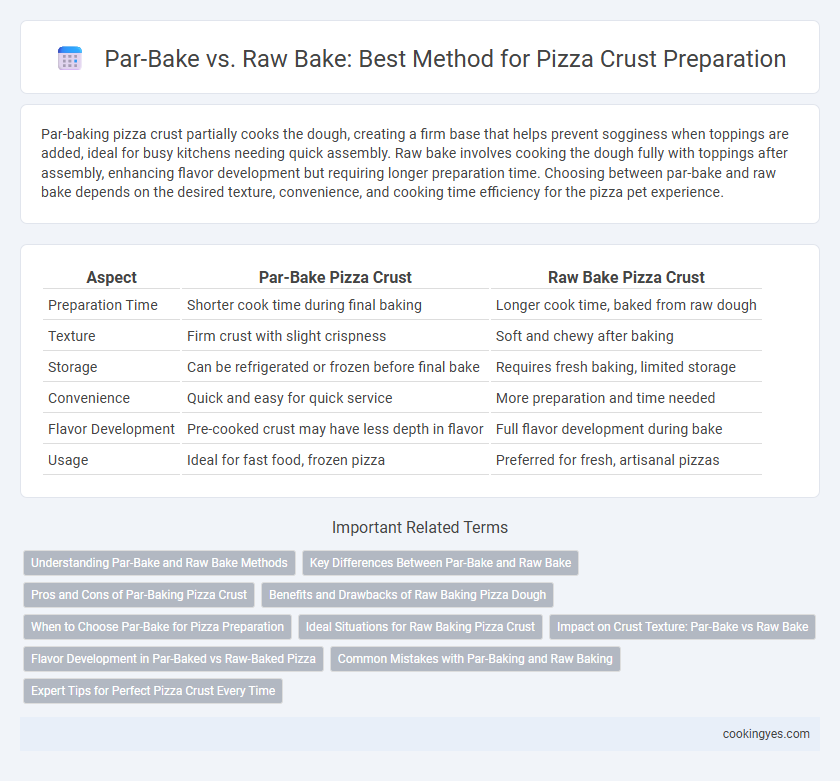Par-baking pizza crust partially cooks the dough, creating a firm base that helps prevent sogginess when toppings are added, ideal for busy kitchens needing quick assembly. Raw bake involves cooking the dough fully with toppings after assembly, enhancing flavor development but requiring longer preparation time. Choosing between par-bake and raw bake depends on the desired texture, convenience, and cooking time efficiency for the pizza pet experience.
Table of Comparison
| Aspect | Par-Bake Pizza Crust | Raw Bake Pizza Crust |
|---|---|---|
| Preparation Time | Shorter cook time during final baking | Longer cook time, baked from raw dough |
| Texture | Firm crust with slight crispness | Soft and chewy after baking |
| Storage | Can be refrigerated or frozen before final bake | Requires fresh baking, limited storage |
| Convenience | Quick and easy for quick service | More preparation and time needed |
| Flavor Development | Pre-cooked crust may have less depth in flavor | Full flavor development during bake |
| Usage | Ideal for fast food, frozen pizza | Preferred for fresh, artisanal pizzas |
Understanding Par-Bake and Raw Bake Methods
Par-bake pizza crust is partially baked to set its structure before adding toppings, preventing a soggy base and ensuring a crisp texture. Raw bake involves placing the dough directly into the oven with toppings, allowing full baking in one process, which can result in a softer, chewier crust. Choosing between par-bake and raw bake methods depends on desired crust texture and cooking efficiency.
Key Differences Between Par-Bake and Raw Bake
Par-bake pizza crust is partially baked before toppings are added, resulting in a firmer base that reduces sogginess and ensures even cooking during the final bake. Raw bake crust starts fully uncooked, absorbing toppings more but requiring precise baking to avoid undercooked or doughy results. Key differences include texture, cooking time, and moisture control, with par-bake offering convenience and consistency, while raw bake provides fresher dough flavor and customization.
Pros and Cons of Par-Baking Pizza Crust
Par-baking pizza crust sets the dough's structure, preventing sogginess from toppings and ensuring a crispier base, ideal for heavy or moist toppings like vegetables and sauce-rich pies. This method shortens final baking time, improving kitchen efficiency in pizzerias and reducing the risk of an undercooked center, but it can lead to a drier crust if overdone and may sacrifice some dough flavor development. Raw bake provides a softer, airier crust with more chew but increases the risk of sogginess and requires precise timing to avoid doughy texture.
Benefits and Drawbacks of Raw Baking Pizza Dough
Raw baking pizza dough allows for maximum control over crust texture and flavor development, producing a fresher, more customizable pizza base. However, raw baking requires precise temperature and timing management to avoid undercooked or soggy crusts, which can lead to uneven texture and longer cooking times. The process benefits artisan pizza makers seeking superior taste, but beginners might struggle with consistency compared to par-baking methods that simplify preparation.
When to Choose Par-Bake for Pizza Preparation
Par-baking pizza crust is ideal when preparing pizzas in advance or for frozen products, as it sets the dough structure while allowing final baking with toppings. This method reduces total baking time and prevents sogginess by partially cooking the crust before adding sauce and ingredients. Par-bake is preferred in commercial kitchens and for home cooks seeking convenience and consistent results.
Ideal Situations for Raw Baking Pizza Crust
Raw bake pizza crust is ideal for fresh, made-to-order pizzas where the dough is hand-tossed and topped immediately, ensuring optimal texture and flavor development. It allows for better control over crust thickness and chewiness, enhancing the overall eating experience when baked in high-temperature ovens like wood-fired or pizza stones. Restaurants and pizzerias aiming for artisanal, customizable pizzas benefit most from raw bake preparation due to its flexibility in topping application and final baking.
Impact on Crust Texture: Par-Bake vs Raw Bake
Par-baking pizza crust partially cooks the dough, resulting in a firmer, crispier base that prevents sogginess when toppings are added, making it ideal for thick or heavily topped pizzas. Raw bake dough absorbs more moisture during cooking, yielding a softer, chewier crust with a tender interior but can risk becoming doughy if not baked at the optimal temperature. The choice between par-bake and raw bake directly influences crust texture, with par-baking enhancing structural integrity and crispness, while raw baking promotes a traditional, softer bite.
Flavor Development in Par-Baked vs Raw-Baked Pizza
Par-baking pizza crust allows partial cooking that enhances flavor development by creating caramelization and Maillard reactions on the dough's surface before final baking. Raw-baked pizza crust often has a lighter, doughier taste due to the absence of pre-bake flavor transformations. Par-baking improves texture and adds a richer, toasted flavor profile essential for gourmet pizza quality.
Common Mistakes with Par-Baking and Raw Baking
Common mistakes with par-baking pizza crust include undercooking the dough, resulting in a soggy crust, and overbaking, which leads to dryness and hardness. Raw baking errors often involve insufficient oven temperature or not preheating the oven properly, causing uneven cooking and a doughy center. Proper timing and temperature control are essential to achieve the ideal balance between a crispy exterior and a fully cooked interior.
Expert Tips for Perfect Pizza Crust Every Time
Par-baking pizza crust involves partially baking the dough before adding toppings, which prevents sogginess and ensures a crispier texture by sealing the surface. Expert chefs recommend par-baking at 425degF for 5-7 minutes to create a sturdy base, ideal for thicker sauces or heavy toppings. Raw baking requires careful dough hydration and oven temperature control, typically baking at 500degF to achieve a chewy, airy crust with a slightly charred bottom.
Par-bake vs raw bake for pizza crust preparation Infographic

 cookingyes.com
cookingyes.com